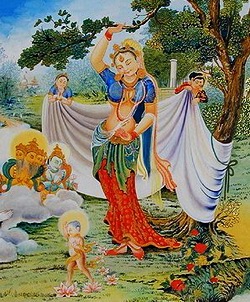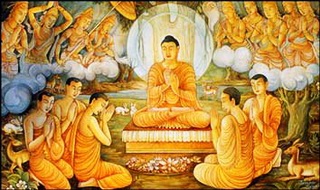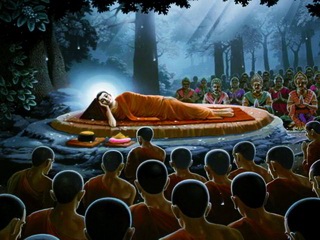Moved by compassion to take birth among man
Before the Buddha was born into this world, he was a bodhisattva in the heavens – a being destined by his karma for full Enlightenment. From here he witnessed the dark ages engulfing the human realm, leading to its spiritual poverty. Moved by compassion, he vowed to take birth in the world and relieve mankind from their sufferings.
Queen Maya’s Dream
When it was time for his rebirth in the human realm, he chose Suddhodana and his wife, Mayadevi, rulers of the Sakya clan, as his future parents. This generous couple was well known throughout the land for their just and noble bearing. The bodhisattva’s descent from the heavens occurred as a dream to Mayadevi. In this dream, a white elephant approached and touched her right side with its trunk. During this night, the bodhisattva entered the womb of Mayadevi and she became pregnant. The palace fortunetellers explained that the dream announced the queen’s pregnancy, and that the newborn would possess exceptional traits of character.
 The Birth of Siddhartha
The Birth of Siddhartha
Mayadevi successfully carried her pregnancy for the full term without any complications or pain. Near the end of her pregnancy, she decided to travel to her parental home to have the baby there with her mother, an ancient custom that is still practiced today. It was the day of the full moon in the month of May. The weather was turning warm and so when she came upon a pleasant grove near the village of Lumbini, she saw the gardens overflowing with a rich profusion of green leaves and flowers and decided to rest. The queen instructed her party to camp among the shady trees. She stepped out of her palanquin and reached to grasp one of the branches of a flowering tree. No sooner had she done so than she felt the throes of birth. Standing thus, with her hand to the branch, she delivered her child, and the the baby destined to be the Buddha was born in the gardens.
Present to witness this momentous birth were the deities and gods. The advent of the newborn was accompanied by many miraculous events and a great cry of rejoicing rose through the heavens and were heard in the surrounding lands. The joyful father gave the baby the name “Siddhartha”, meaning “accomplisher of aims”. He was also called “Gautama”, which was his clan name. Later he would also be called Sakyamuni or the sage of the Sakya clan.
A Youth Dedicated to the Mastery of Learning and Athletics
A week after giving birth, Mayadevi died, and her sister Mahapajapati raised the prince. As the son of the king, Siddhartha was provided with the finest upbringing and the greatest luxuries. He received the finest education and mastered all lessons taught to him. In his younger years, he excelled in sports and other contests of skill. The vigorous training befitted the grooming of a future monarch. He was said to particularly excel on the horse and with the bow. He enjoyed all the pleasures of youth but even so he was already known for his wisdom and compassion.
At the early age of sixteen, he married his beautiful cousin of equal age, Yasodhara. For nearly thirteen years, after his happy marriage, he led a luxurious life, blissfully ignorant of the vicissitudes of life outside the palace gates. Of his luxurious life as prince, he states:
“I was delicate, excessively delicate. In my father’s dwelling three lotus-ponds were made purposely for me. Blue lotuses bloomed in one, red in another, and white in another. I used no sandal-wood that was not of Kasi. My turban, tunic, dress and cloak, were all from Kasi.”
“Night and day a white parasol was held over me so that I might not be touched by heat or cold, dust, leaves or dew.”
“There were three palaces built for me — one for the cold season, one for the hot season, and one for the rainy season. During the four rainy months, I lived in the palace for the rainy season without ever coming down from it, entertained all the while by female musicians. Just as, in the houses of others, food from the husks of rice together with sour gruel is given to the slaves and workmen, even so, in my father’s dwelling food with rice and meat was given to the slaves and workmen.”
With the progress of time, he gradually realised that life is always accompanied with sorrow. He thought to himself:
“Why do I, being subject to birth, decay, disease, death, sorrow and impurities, thus search after things of like nature. How, if I, who am subject to things of such nature, realize their disadvantages and seek after the unattained unsurpassed, perfect security which is Nibbana!”
“Cramped and confined is household life, a den of dust, but the life of the homeless one is as the open air of heaven! Hard is it for him who bides at home to live out as it should be lived the Holy Life in all its perfection, in all its purity.”
His contemplative nature and boundless compassion no longer permitted him to spend his time in the mere enjoyment of the fleeting pleasures of the Royal palace. He knew no personal grief but he felt a deep pity for suffering humanity.
The Renunciation of Worldly Life
Having made the decision, Siddhartha requested his father to allow him to proceed in his quest for truth. On hearing of the prince’s resolve, his father became extremely anxious and entreated him to revert his decision. However, when Siddhartha heard that a child had been born to him, he decided to make a final break. He left the luxurious palace of his father, leaving behind his devoted wife and son.
The first thing Gautama did after leaving his father’s palace was to cut off his long and beautiful hair with his sword. He also exchanged his princely clothes for robes of rags and set forth into the wilderness for a new life in a quest for liberation.
The Six Years of Austerities
Wandering in his search for Enlightenment, Siddhartha came to a pleasant hermitage by a lovely river, where, for six years, he joined five other ascetics in a way of discipline based on progressively severe fasting. Consequently, his bones stuck out like a row of spindles, and when he touched his stomach, he could almost feel his spine. His hair fell out and his skin became withered.
But all this was in vain. However severe his austerities, he gained no real insight into the mysteries of life. He had to face the fact that asceticism had failed to advance him in his quest. He was exhausted from his practice, but one day he heard a passing musician tuning his lute, the strings of which were pulled neither too tight nor left too slack. It dawned upon him that even as he has enjoyed the extreme of sensual pleasure, physical austerity is the other, and that the “Middle Way” between these two extremes is the path to Enlightenment.
He thus slowly rose, and went to bathe in the river. He crossed over to the far bank where a village girl offered him a bowl of milk rice. It was the first rich food he had accepted in a long time and it instantly restored his body to strength.
Thus nourished, Siddhartha sat under the great and shady bodhi tree near the village of Gaya, just south of the great Himalayas, to make his last bid for liberation. Absorbing himself fully in meditation, he vowed not to move from that spot until he had fulfilled his quest.
 The Enlightenment
The Enlightenment
Hearing this solemn vow, Mara, the manifestation of death and desire, felt threatened. Mara’s power over sentient beings originated from their attachment to sensuous pleasures and the consequent fear of death which leads to intense suffering. Enlightenment would free Siddhartha from Mara’s control and provide an opportunity for others to free themselves also by emulating him.
Mara first sent his three beautiful daughters named Desire, Hatred and Lust. However, Siddhartha had already disengaged himself from these defilements of the mind and thus remained unmoved. This prompted Mara to attempted to intimidate Siddhartha with fear by generating an army of wrathful and hideous creatures, the very personifications of death. But all through these tribulations, Siddhartha sat calm and unflinching, and Mara’s weapons fell uselessly before Siddhartha. Mara had no other recourse than to withdraw. Thus was cleared the final hurdle on the way to Siddhartha’s enlightenment. As Siddhartha meditated under the bodhi tree, he came to understand the nature of existence and discovered a path that led to release from the inherent suffering we all experience. He also recalled his past lives and saw that we are all born many times and the conditions we are born into are dependent on our thoughts and actions. Finally on this full moon night in the month of May he broke through the bonds of ignorance and delusion and attained to unsurpassed liberation of the mind – full Enlightenment. As he was alone with no one to witness this momentous event, he called the Earth itself to be his witness by touching the ground with his right hand
“In the world including gods there is no rival to me. Indeed an Arahant am I in this world. An unsurpassed teacher am I; alone am I the All-Enlightened. Cool and appeased am I. To establish the wheel of Dhamma, to the city of Kasi I go. In this blind world I shall beat the drum of deathlessness. ~ Ariyapariyesana Sutta”
 The Proclamation of the Teachings
The Proclamation of the Teachings
Having gained Enlightenment, Gautama came to be called the Buddha; the Awakened One, indicating the unique quality of his mind. Initially he was hesitant to teach others of his achievement, doubting that people would be able to realise or understand the deep and profound nature of his realisations. But the god Brahma entreated him to teach saying that there were beings ‘with little dust in their eyes’ who would be able to understand his teachings. He first went up to Sarnath where he met the five disciples who were his previous companions. Though they had deserted him after he had given up the practice of asceticism, the awesome aura from the Buddha now attracted them. Here, he gave his first sermon setting in motion the wheel of the Dhamma as he expounded the doctrine of the Four Noble Truths and the Eightfold Path. Hearing his discourse, they became his first followers. Kondanna, one of the five was the first to destroy the lesser fetters in his mind and became the first saintly disciple of the Buddha.
“But when Awakened Ones arise in the world, bringing light to the world, they proclaim the Dhamma leading to the stilling of stress.~ Vippalasa Sutta”
Over the next 45 years, the Buddha traveled great distances traversing the Ganges valley and teaching people from all classes of society. These were princes, noblemen, warriors, beggars, prostitutes, traders and children. Following the Buddha’s instructions thousands were ordained as monks and nuns. These monks and nuns as well as many lay people, following the Buddha’s instructions were able to purify their mind of delusion and also attain to Enlightenment, thus liberating themselves from the bonds of existence.
“Just as the ocean has one taste, the taste of salt, even so, this Dhamma has one taste too, the taste of freedom ~ Udana 56”
 The Final Passing into Parinibbana
The Final Passing into Parinibbana
After a career that brought him to the age of 80 Buddha finally reached the city of Kusinara, where he asked his disciples to spread a couch for him in a grove of trees. He laid there, reclining on his right side, facing west, with his head supported by his hand.
He realised clearly that death was approaching. Towards midnight of the same day, the event known in Buddhist terminology as the Parinibbana, or “Final Nirvana” took place. It was another full-moon night. The Enlightened One brought his mind through various planes of meditation until he passed away into final liberation from this existence. The trees burst into full bloom even though it was out of season, and showered the entire grove with their flowers. And the world was like a mountain whose summit has been shattered by a thunderbolt; it was like the sky without the moon.
“Open to all are the doors to the Deathless. Let those who will hear respond with faith. ~ Ariyapariyesana Sutta”